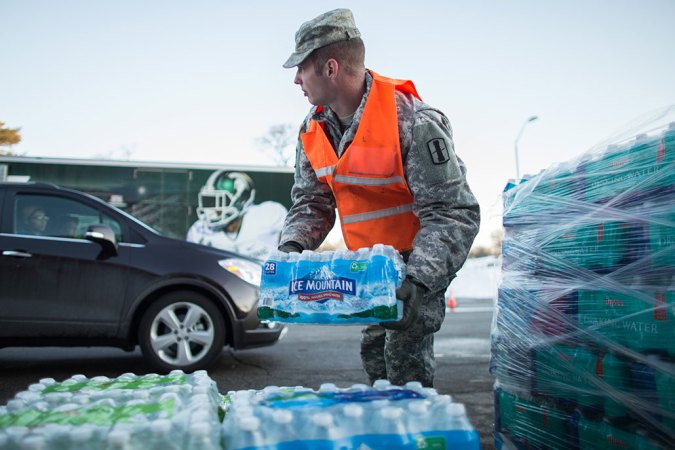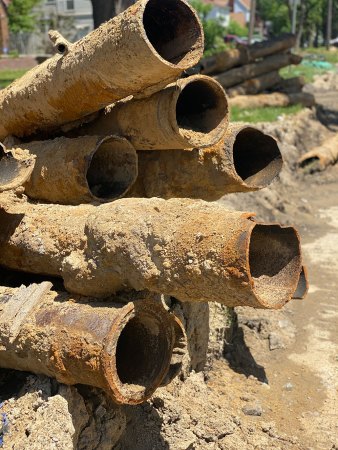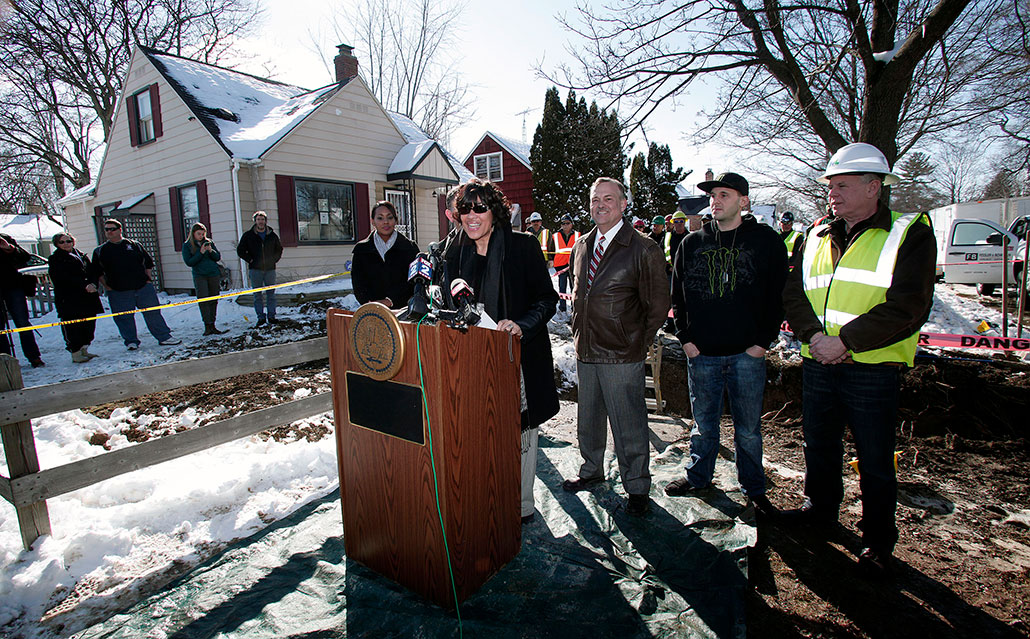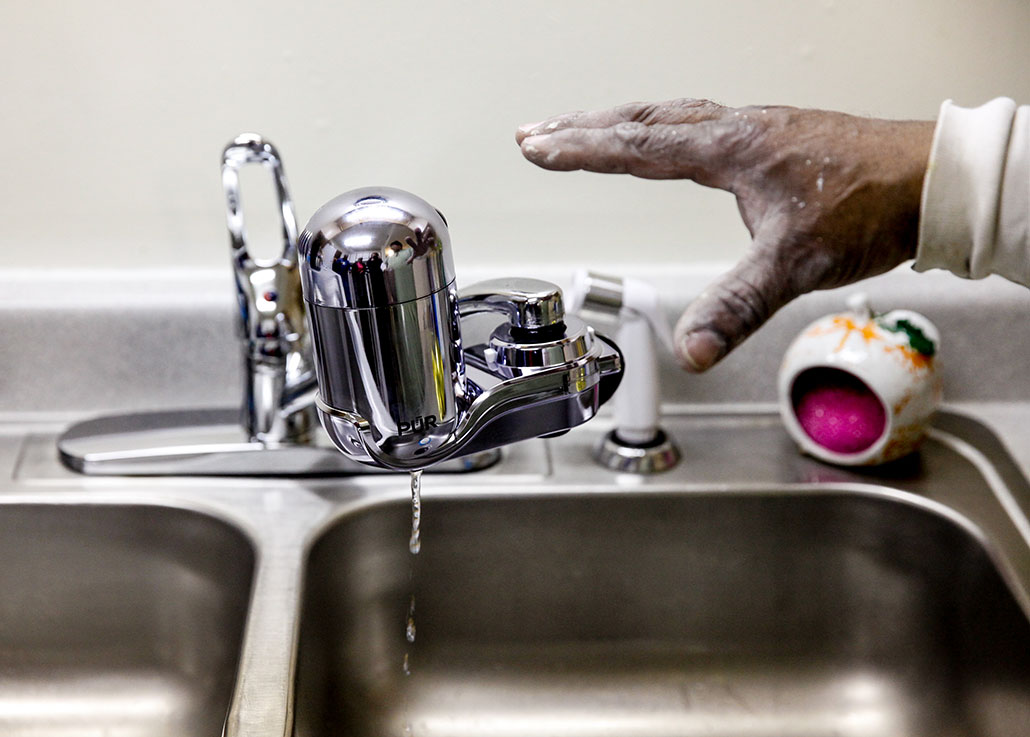Health problems persist in Flint 10 years after water poisoning
A switch in water source tainted the Michigan city’s drinking water with toxic lead

The Flint River flows near downtown Flint, Mich. The city started using the river for drinking water in 2014. That move led to a series of events that exposed many local people to high levels of lead for more than a year. Even with cleaner water now available, locals still face health problems and fears.
Seth Herald/AFP/Getty Images News
Share this:
- Share via email (Opens in new window) Email
- Click to share on Facebook (Opens in new window) Facebook
- Click to share on X (Opens in new window) X
- Click to share on Pinterest (Opens in new window) Pinterest
- Click to share on Reddit (Opens in new window) Reddit
- Share to Google Classroom (Opens in new window) Google Classroom
- Click to print (Opens in new window) Print
When Everett Graham was in grade school, news broke of a sharp spike in levels of lead in kids’ blood. Lead is a toxic heavy metal that can cause a variety of health and learning problems. His hometown — Flint, Mich. — had changed the source of its drinking water. And now the whole town faced a major public health emergency.
“Overnight, we went from being able to drink from the water fountains at school,” Graham recalls, to learning that water wasn’t safe. Instead, he carried bottled water almost all the time.
Ten years have passed since that water source was switched to the polluted Flint River. The city switched back to its previous source in late 2015. But massive damage was done. And “the crisis still isn’t solved,” notes Graham, now a student at Michigan State University in Lansing.
A choice to put money savings ahead of public health caused — and later prolonged — Flint’s water woes.
The water crisis harmed the health of many children and adults in Flint, studies have shown. Mental health problems have surfaced, too. They include learning problems, behavioral issues, anxiety and depression. Though city residents are working to make things better, many still face an uphill battle.
One reason: U.S. homes built before 1986 often used lead pipes to connect them to city water supplies. In many places, that use of lead pipes was required. Faucets and shower heads in many homes used lead, too.
And lead doesn’t always stay in those pipes and plumbing fixtures. It can leach into the water. When people drink that water, the lead gets into their bodies.
Flint isn’t the only city that has suffered from lead and other contaminants in its drinking water. Washington, D.C., had a big problem in 2004. Drinking water for large parts of Newark, N.J., had high levels of lead from 2016 to 2019. Lead has also contaminated the drinking water in even bigger cities, including Chicago, Ill., and New York City.
Yet Flint has become a poster child for the risks that lead can pose to health, including kids’ growing minds and bodies. There, the city’s lead problems resulted from a deliberate switch away from a clean water source. And impacts on the community continue even 10 years later.

A human-caused crisis
Melodie Marsh remembers when the National Guard brought water bottles to her home in early 2016. Having soldiers show up to say the water was not safe “was just a scary moment,” she says.

The next day she went to her school in another town.
“Everybody was looking at me because I was a Flint resident,” she recalls. It was as if there had been something wrong with her, not the water. “That,” she recalls, “was probably one of the hardest experiences I’ve had with the water crisis.”
Marsh now goes to Howard University in Washington, D.C. People still ask about the water when they hear she’s from Flint. “It’s hard to get rid of the stigma,” she says.
So how did her town’s water get poisoned with lead?
It started with the city of Flint having money problems. A state law let then-governor Rick Snyder send in managers to get struggling cities’ finances back on track. Eleven factors were supposed to guide such decisions. Cities that relied more on state funding were more likely to get state-appointed managers. But other factors seemed to play a role, too. The state was more likely to take over in cities with more low-income households and larger Black populations, a 2021 study found.

Snyder sent such managers to Flint starting in 2011. Flint had nearly 80,000 people. More than half of the residents were Black and about a third lived in poverty.
Until 2014, Flint got its drinking water from the city of Detroit. Switching to another supplier could save money. But it would take time to build a pipeline to bring in clean water from a less costly source. So when Flint’s contract to buy Detroit water ended, the city began pumping water from the Flint River. It started on April 25, 2014.
The state-appointed emergency manager made this decision. “[He] did not have to get the buy-in or approval of local elected officials or residents,” says Kent Key. He studies health disparities at Michigan State University in Flint. If the manager had listened to local people, he would have known the river was polluted, Key says.
The city’s old water plant could not clean the river water properly. More importantly, the river water was corrosive. And the water plant failed to fix that problem. Soon some iron pipes released rust into the water. And lead leached from lead pipes that carried this water to people’s homes. So people’s tap water now held lead and rust, plus other contaminants.
The water now looked and tasted bad
Residents complained even before they knew about the lead problem, Key says. Some said their water now looked brown. Others objected to its smell and bad taste. Some people came down with lung infections. Others got skin rashes or lost hair after washing in the water.
“Residents were protesting,” Key says. “They were marching. They were going to Lansing,” the state capital.
At first, the city said the water was safe. Then officials told people to boil the water. Boiling can treat some water problems. It can kill bacteria and reduce levels of some chemicals. Boiling can’t, however, remove lead.
In 2015, environmental experts at Virginia Tech University in Blacksburg tested Flint’s water. The engineers found elevated levels of lead in water samples from homes there. Lead is toxic — a poison. People may not see or taste it, but lead can harm them in many ways. Studies have found even tiny amounts are unsafe.
Being neurotoxic, lead can affect the brain. The developing brains of babies and young children are especially at risk. Exposure during this critical time can disrupt learning and other brain functions. Lead also can raise the risks of mental illness and behavior problems.
By 2015, the blood of nearly one in 20 young children in Flint had lead levels of 5 micrograms per tenth of a liter (µg/dL) or more. That’s about twice the rate seen two years earlier — before the water switch.
Mona Hanna-Attisha is a pediatrician at Michigan State University in Flint. She and others measured those increased levels of lead in blood. They reported on them in 2016 in the American Journal of Public Health. (She later wrote a book, What the Eyes Don’t See, about what it took to recognize the problem and get those data.)

Nineteen months after the switch to Flint River water, government officials finally admitted there was a problem. Gov. Snyder called the National Guard to Flint.
Graham, Marsh and others now knew they faced a scary situation.
Impacts on health
Physical and mental health problems spiked after the city’s switch to Flint River water, studies show.
Jerel Ezell works at the University of California, Berkeley. He studies social factors that affect rates of diseases. He and others surveyed Flint residents in 2019. Nearly half of the 331 adults in the study reported developing skin rashes after the water switch. Almost four in 10 children they cared for also got skin rashes. Many people lost some of their hair — four in 10 adults and about one in 10 kids. And about three in 10 adults reported nausea after drinking water sourced from the Flint River.

Doctors also diagnosed many adults and kids with high levels of lead in their blood, Ezell and his colleagues found. Among adults, one in 10 had been told they had high lead levels. Another study by Ezell and others included children whose blood was tested for lead. Roughly one-third of them had high levels of lead, based on the results given to parents and caregivers.
Exposure to lead “is not going to have the same impact from one kid to the next,” Ezell says. But studies show that high blood-lead levels can cause problems, such as permanently lowering IQ — especially in babies and young children. Not surprisingly, Ezell and others found, caregivers were more likely to report delays in learning and understanding among Flint kids who had high levels of lead in their blood.
Sam Trejo is a sociologist at Princeton University in New Jersey. He and others reviewed data for school children in Flint from 2006 to 2019. They compared it against combined data from similar school districts in Michigan to gauge what likely would have happened in Flint without the water crisis. As a group, Flint’s kids did worse in math, on average, after the water switch than the other districts’ data suggested would have been the case without the switch. The percentage of Flint’s students who needed special-education services also rose after the water crisis, compared to expectations based on data from other districts.
However, estimated blood-lead levels of the Flint kids couldn’t explain all the differences, Trejo’s team found. They concluded that psychological and social impacts likely played some role, too. These researchers shared their findings in an October 2021 report for the National Bureau of Economic Research.

The water crisis was a trauma for Flint
Indeed, lead and other water pollutants were not Flint’s only problem. Living through the water crisis was its own trauma, Ezell says. Denying that, he stresses, would “sell short the experience of people who live in places like Flint.”
After all, city residents knew their families were exposed to tainted water. Many felt the government didn’t care about them or their health. And the government didn’t quickly move to fix problems when the residents first complained.
What’s more, lead’s impacts may not show up right away. So now people need regular screening to check for health effects from lead. And many worry about their families. Don’t forget, Ezell adds, many Flint residents also face poverty, racism and other stresses.
Nicole Jones is an epidemiologist — a disease detective — in Flint. She works for Michigan State University and the Hurley Children’s Hospital Public Health Initiative. In one study, her team asked parents about their kids’ behavior. More than four in 10 kids were at risk or had symptoms for things like hyperactivity, conduct problems or aggression, her team found.

Jones was part of another study that asked about mental health problems in Flint’s children and teens. Nearly 13 percent — almost one in eight — showed signs of anxiety, that team found. That was almost one-third higher than the national average at the time. And the rate of depression among Flint’s kids was nearly twice the national rate of 4.4 percent.
“What’s important to us is to make sure kids are getting connected to resources” for help, Jones says. The team shared its findings in the December 2023 issue of the American Journal of Public Health.
Anxiety and depression are serious, says her colleague Crystal Cederna. She’s a child psychologist at Michigan State and Hurley Medical Center in Flint. Both conditions hurt a kid’s ability to enjoy life, among other things. They can affect friendships and family relationships. And they can interfere with schoolwork and other parts of normal life. But, Cederna adds, “things like anxiety and depression are super treatable.”
Do you have a science question? We can help!
Submit your question here, and we might answer it an upcoming issue of Science News Explores
Adults were also affected
Mental health problems showed up in adults as well.
Aaron Reuben studies psychology and environmental health at Duke University in Durham, N.C. He and others surveyed adults in Flint in 2019. This was five years after the switch to Flint River water. The responses suggested more than one-fifth of the adults had been depressed within the past year. That’s more than twice the rates elsewhere in Michigan, the United States and the world in general.
Survey answers also showed nearly one in four adults in Flint likely had post-traumatic stress disorder, or PTSD. That’s about twice the rate for people in the military who are coming home from war or other combat.
Reuben says his team thought there would be higher-than-average rates for PTSD and depression. But what they found was worse than they expected. The survey can’t directly link these mental health problems to the water crisis. But the results clearly show a community in distress.
When offered mental health services to deal with their concerns over the water crisis, many community members used them, Reuben said. That suggests people felt concerned about their mental health. However, nearly three quarters of the survey respondents said no one had offered them that help.
His team shared its findings September 2022 in JAMA Network Open.
Reasons for hope
Michigan State student Everett Graham doesn’t drink tap water when he comes home to Flint. And Melodie Marsh still won’t drink from water fountains. “We don’t trust our officials anymore,” she says. “We’ve been lied to multiple times about our water.”
Nearly two-thirds of the people in Reuben’s study likewise had little or no confidence in government assessments of their water’s safety.
Flint’s water now comes from Lake Huron again. And it meets federal drinking water standards. Yet in 2023, city, state and federal authorities still recommended using faucet filters to remove lead.
The best way to reduce exposure is to remove possible sources of lead. Settlement of a court case has paid to replace lead-based water lines for almost all Flint homes that needed it. And a 2021 U.S. law offers funding to speed up the replacement of lead pipes in communities throughout the country.
Flint has been through a lot because of the water crisis. Yet Graham says the city’s people and their talents are “the best part of our community.”
“If somebody were to ask me my favorite thing about Flint, it’s our resiliency and how many change-makers that we have,” adds Marsh. “I feel that everybody in Flint … is pushing for a change in this town.”







